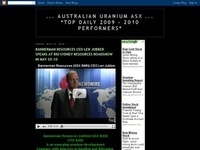Published on Sunday May 29 2011 (AEST)

“You may see $80/lb late this year or early next year, I think it’s within the next year at the most,” he said.
The price of the nuclear fuel plummeted by about 15% after the Japanese Tsunami caused radioactive leaks at the Fukushima-Daiichi plant, but it has now stabilised at around $57,50, according to US-based Ux Consulting.
“I don’t have a crystal ball, but I think that there’s a supply deficit issue that should favour the price moving higher,” Adnani said.
In an earlier presentation, he showed how there could be a 45-million-pound deficit in uranium supply once the Russia-US agreement to convert nuclear warheads into fuel expires in 2013, with demand totaling 175-million pounds yearly.
Adnani said the company will produce at a rate of one-million pounds a year within the next twelve months, at a cost of around $18/lb.
PRODUCTION GROWTH
UEC will then ramp up production to around 1,5-million pounds a year in the next two-to-three years, through the addition of new orebodies to its Texas operations.
The Hobson facility has capacity to produce three-million tons of uranium yearly, and Adnani said this level could be reached by about 2016.
Earlier this month, UEC closed the acquisition of a Paraguayan uranium property, and the company aims to report its first resource statement by the end of the year.
The deposit can also be mined using in-situ methods, said Adnani.
“We may look at a couple of other things, but it has to fit with what we’re doing. Right now’s a great time to buy, because it’s not going to get any cheaper than this,” commented Adnani.
SUPPLY AGREEMENT
UEC was set to sign its first supply deal within the next two weeks, he added, declining to say who it was with.
“We’re talking to a number of these guys, I’m not sure which will be the first one, it’s just based on some fine details we’re negotiating.”
In other nuclear news, trading company Traxys announced on Thursday that it would buy all the uranium that the US department of energy is using to pay a contractor to clean up a closed uranium enrichment plant.
The deal involved 1 605 tons/y of uranium Hexafluoride, which would have otherwise entered the spot market, putting pressure on prices.
 Australian Uranium News - Research
Australian Uranium News - Research


No comments:
Post a Comment